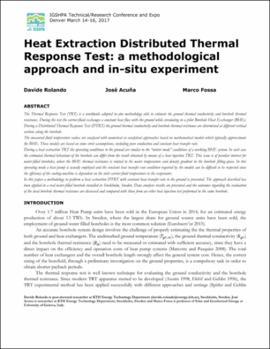| dc.contributor.author | Rolando, Davide | |
| dc.contributor.author | Acuna, Jose | |
| dc.contributor.author | Fossa, Marco | |
| dc.contributor.other | IGSHPA Technical/Research Conference and Expo (2017) | |
| dc.date.accessioned | 2017-03-06T15:38:28Z | |
| dc.date.available | 2017-03-06T15:38:28Z | |
| dc.date.issued | 2017 | |
| dc.identifier | oksd_igshpa_2017_Rolando | |
| dc.identifier.uri | https://hdl.handle.net/11244/49337 | |
| dc.description.abstract | The Thermal Response Test (TRT) is a worldwide adopted in-situ methodology able to estimate the ground thermal conductivity and borehole thermal resistance. During the test the carrier-fluid exchanges a constant heat flux with the ground while circulating in a pilot Borehole Heat Exchanger (BHE). During a Distributed Thermal Response Test (DTRT) the ground thermal conductivity and borehole thermal resistance are determined at different vertical sections along the borehole. The measured fluid temperature values are analysed with numerical or analytical approaches based on mathematical models which typically approximate the BHE. Those models are based on some strict assumptions, including pure conduction and constant heat transfer rate. During a heat extraction TRT the operating conditions to the ground are similar to the "winter mode" conditions of a working BHE system. In such case the estimated thermal behaviour of the borehole can differ from the result obtained by means of a heat injection TRT. This issue is of peculiar interest for water-filled boreholes, where the BHE thermal resistance is related to the water temperature and density gradient in the borehole filling-space. In this operating mode a heat pump is usually employed and the constant heat transfer rate condition required by the models can be difficult to be respected since the efficiency of the cooling-machine is dependent on the inlet carrier-fluid temperature to the evaporator. In this paper a methodology to perform a heat extraction DTRT with constant heat transfer rate to the ground is presented. The approach described has been applied in a real water-filled borehole installed in Stockholm, Sweden. Data analysis results are presented and the outcomes regarding the evaluation of the local borehole thermal resistance are discussed and compared with those from an erlier heat injection test performed in the same borehole. | |
| dc.format | application/pdf | |
| dc.language | en_US | |
| dc.publisher | International Ground Source Heat Pump Association | |
| dc.rights | In the Oklahoma State University Library's institutional repository this paper is made available through the open access principles and the terms of agreement/consent between the author(s) and the publisher. The permission policy on the use, reproduction or distribution of the article falls under fair use for educational, scholarship, and research purposes. Contact Digital Resources and Discovery Services at lib-dls@okstate.edu or 405-744-9161 for further information. | |
| dc.subject | ground source heat pump systems | |
| dc.subject | heat transmission | |
| dc.subject | geothermal engineering--mathematical models | |
| dc.title | Heat extraction distributed thermal response test: A methodological approach and in-situ experiment | |
| osu.filename | oksd_igshpa_2017_Rolando.pdf | |
| dc.identifier.doi | 10.22488/okstate.17.000536 | |
| dc.type.genre | Conference proceedings | |
| dc.type.material | Text | |
